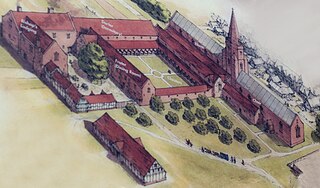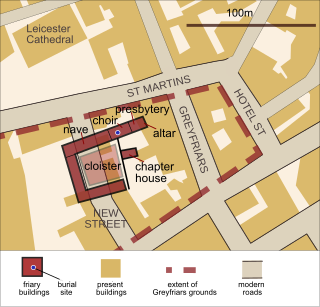
The dissolution of the monasteries, occasionally referred to as the suppression of the monasteries, was the set of administrative and legal processes between 1536 and 1541, by which Henry VIII disbanded monasteries, priories, convents, and friaries in England, Wales, and Ireland; expropriated their income; disposed of their assets; and provided for their former personnel and functions.

Elizabeth Barton, known as "The Nun of Kent", "The Holy Maid of London", "The Holy Maid of Kent" and later "The Mad Maid of Kent", was an English Catholic nun. She was executed as a result of her prophecies against the marriage of King Henry VIII of England to Anne Boleyn.
Edward Bocking was a Benedictine monk executed in 1534. He was the confessor and spiritual adviser of Elizabeth Barton, "The Holy Maid of Kent", a popular seer who spoke out against the marriage of King Henry VIII to Anne Boleyn. The extent to which he may have influenced Barton's prophecies and pronouncements is unclear.

Agnellus of Pisa, OFM, was an Italian Franciscan friar. As its first Minister Provincial in England (1224–1236), he is considered the founder of the Franciscans in England. His feast day is variously observed on 7 May or 10 September.

John Stone, OSA was an English Augustinian friar who was executed, probably in December 1539; he was canonized in 1970 by Pope Paul VI. He was a doctor of theology from Canterbury.
Thomas Belchiam (1508–1537) was an English Franciscan who died in Newgate Prison in the reign of Henry VIII. He is a Catholic martyr, declared venerable by Pope Leo XIII. The year of death is in question: the Victoria County History for Kent puts the events in 1534. It references Thomas Bourchier's Historia Ecclesiastica de Martyrio Fratrum..., "though the writer assigns them to 1537". Dom Bede Camm, O.S.B., places Belchiam's date of death as 3 August 1537. Notes and Queries lists him as dying in 1538.
Henry Standish was an English Franciscan, who became Bishop of St. Asaph. He is known as an opponent of Erasmus in particular, and humanists in general.
Events from the 1530s in England.
Events from the 1480s in England. This decade marks the beginning of the Tudor period.

John Forest was an English Franciscan friar and martyr. Confessor to Queen Catherine of Aragon, Forest was burned to death at Smithfield for heresy, in that he refused to acknowledge the King as head of the church.
Anthony Brookby (Brorbey) was an English Franciscan theologian. He offended Henry VIII, and became a Catholic martyr.

The Franciscan Friary was once a large estate located on the west side of Lichfield city centre in Staffordshire. The estate was built and inhabited by the Franciscan Friars from 1237. At one time the estate consisted of a large church, a cloister, dormitory lodge and a refectory building as well as many other domestic dwellings.

In London, the Greyfriars was a Conventual Franciscan friary that existed from 1225 to 1538 on a site at the North-West of the City of London by Newgate in the parish of St Nicholas in the Shambles. It was the second Franciscan religious house to be founded in the country. The establishment included a conventual church that was one of the largest in London; a studium or regional university; and an extensive library of logical and theological texts. It was an important intellectual centre in the early fourteenth century, rivalled only by Oxford University in status. Members of the community at that time included William of Ockham, Walter Chatton and Adam Wodeham. It flourished in the fourteenth and fifteenth century but was dissolved in 1538 at the instigation of Henry VIII as part of the Dissolution of the Monasteries. Christ's Hospital was founded in the old conventual buildings, and the church was rebuilt completely by Sir Christopher Wren as Christ Church Greyfriars after the original church was almost completely destroyed in the Great Fire of London of 1666. The building now standing on the site, designed by Arup Group Limited, is currently occupied by Merrill Lynch.

Greyfriars, Leicester, was a friary of the Order of Friars Minor, commonly known as the Franciscans, established on the west side of Leicester by 1250, and dissolved in 1538. Following dissolution the friary was demolished and the site levelled, subdivided, and developed over the following centuries. The locality has retained the name Greyfriars particularly in the streets named "Grey Friars", and the older "Friar Lane".
John London, DCL was Warden of New College, Oxford, and a prominent figure in the Dissolution of the Monasteries during the reign of Henry VIII of England.
John Philpot was an Archdeacon of Winchester and an English Protestant martyr whose story is recorded in Foxe's Book of Martyrs. He was the third son of Sir Peter Philpot and was born at Compton, Hampshire, in 1516.
Newark Friary, also known as Newark Greyfriars, and Newark Observant Friary, was a friary of the reformed "Observant Friars" of the Franciscan Order, located in the town of Newark, Nottinghamshire, England. The friary as founded by Henry Tudor c. 1499, and dissolved by his son, Henry VIII, in 1539.








